Do you have a question about the Ducati 1098 2007 and is the answer not in the manual?
Overview of the manual's structure, symbols, and general advice.
Details specific to the motorcycle model, including frame and engine identification numbers.
Comprehensive technical data including dimensions, specifications, fluids, and tools.
Guides on operating the motorcycle and performing routine maintenance tasks.
Procedures related to the motorcycle's body panels and fairings.
Details on throttle, clutch, front brake, rear brake, and gearchange controls.
Procedures for front wheel, front fork, hydraulic brakes, rear wheel, swingarm, rear suspension, and final drive.
Details on handlebars, steering, steering damper, footrests, stands, frame inspection, and number plate holder.
Covers fuel tank, airbox, throttle body, air intake, and exhaust system procedures.
Details on fuel injection, ignition system components, ECU, sensors, and coils.
Comprehensive guide to engine removal, refitting, lubrication, cooling, cylinder head, clutch, gearbox, and flywheel/alternator.
Details the motorcycle's electrical system, including wiring diagrams and component functions.
Essential for understanding the document's structure and notation.
Key for understanding symbols, abbreviations, and references used in the manual.
Details crucial safety information regarding hazardous materials and potential dangers.
Provides detailed technical specifications for the motorcycle, covering various components and systems.
Important for understanding clearances and fitment of parts.
Essential information on fluids required for maintenance.
Lists critical torque values for engine and frame components, essential for proper assembly.
Lists specialized tools required for engine and frame maintenance, ensuring correct procedures.
Covers essential checks before operating the motorcycle.
Outlines key maintenance tasks, including fluid checks, filter changes, and adjustments.
Information on using diagnostic tools like multimeters and the DDS tester for troubleshooting.
Procedures for removing and refitting the headlight shell and rear-view mirrors.
Covers removal and refitting of side and front fairing panels.
Details on removing and refitting the seat, seat cowling, and side panels.
Covers adjusting, removing, and refitting the throttle cable and twistgrip.
Details on removing and refitting the clutch master cylinder and slave cylinder assemblies.
Procedures for removing and refitting the front brake master cylinder.
Covers removal, disassembly, and refitting of the rear brake control system.
Details on removing, disassembling, and refitting the gearchange mechanism.
Procedures for removal, overhaul, and refitting of the front wheel.
Covers removal, overhaul, and refitting of the front fork assembly.
Details maintenance operations and procedures for the front hydraulic brake system.
Procedures for removal, overhaul, and refitting of the rear wheel.
Covers removal, inspection, overhaul, and refitting of the rear swingarm.
Details removal and refitting of the rear brake caliper and disc.
Covers rear suspension system, shock absorber, rocker arm, and tie-rod procedures.
Inspection and maintenance of the front and rear sprockets, chain, and drive system.
Procedures for removal and refitting of the handlebars.
Covers adjusting steering head bearings and steering angle.
Instructions for checking the structural integrity and dimensions of the frame.
Covers removal, refitting, and servicing of the fuel tank and its associated components.
Procedures for removing and refitting the throttle body, airbox, and related hoses.
Covers removal and refitting of air filters and associated components.
Details removal and refitting procedures for the exhaust system components.
Details the electronic control unit (ECU) and its connected sensors, critical for engine operation.
Step-by-step guide for removing and reinstalling the entire engine.
Critical procedure for checking and adjusting valve clearances for optimal engine performance.
Covers the engine timing system setup and adjustments.
Detailed instructions for overhaul of cylinder head components, including valves and rocker arms.
Covers the disassembly and overhaul of cylinder and piston components.
Comprehensive guide to clutch assembly, including inspection and overhaul of components.
Covers the overhaul and reassembly of gearbox shafts, critical for transmission.
Instructions for servicing the flywheel and alternator assembly.
Procedures for disassembling, overhauling, and reassembling crankcase halves.
Focuses on the overhaul and reassembly of connecting rods and crankshaft components.
Provides a comprehensive wiring diagram for all electrical systems on the motorcycle.
Essential information on checking, recharging, and topping up the battery system.
Covers the components and operation of the electric starting system.
Details the replacement and checking of various lights and indicating devices.
Explains the instrument panel, its display, and functions.
Covers the immobilizer system, keys, antenna, and programming procedures.
Information on using diagnostic tools like multimeters and the DDS tester for troubleshooting.
Overview of the manual's structure, symbols, and general advice.
Details specific to the motorcycle model, including frame and engine identification numbers.
Comprehensive technical data including dimensions, specifications, fluids, and tools.
Guides on operating the motorcycle and performing routine maintenance tasks.
Procedures related to the motorcycle's body panels and fairings.
Details on throttle, clutch, front brake, rear brake, and gearchange controls.
Procedures for front wheel, front fork, hydraulic brakes, rear wheel, swingarm, rear suspension, and final drive.
Details on handlebars, steering, steering damper, footrests, stands, frame inspection, and number plate holder.
Covers fuel tank, airbox, throttle body, air intake, and exhaust system procedures.
Details on fuel injection, ignition system components, ECU, sensors, and coils.
Comprehensive guide to engine removal, refitting, lubrication, cooling, cylinder head, clutch, gearbox, and flywheel/alternator.
Details the motorcycle's electrical system, including wiring diagrams and component functions.
Essential for understanding the document's structure and notation.
Key for understanding symbols, abbreviations, and references used in the manual.
Details crucial safety information regarding hazardous materials and potential dangers.
Provides detailed technical specifications for the motorcycle, covering various components and systems.
Important for understanding clearances and fitment of parts.
Essential information on fluids required for maintenance.
Lists critical torque values for engine and frame components, essential for proper assembly.
Lists specialized tools required for engine and frame maintenance, ensuring correct procedures.
Covers essential checks before operating the motorcycle.
Outlines key maintenance tasks, including fluid checks, filter changes, and adjustments.
Information on using diagnostic tools like multimeters and the DDS tester for troubleshooting.
Procedures for removing and refitting the headlight shell and rear-view mirrors.
Covers removal and refitting of side and front fairing panels.
Details on removing and refitting the seat, seat cowling, and side panels.
Covers adjusting, removing, and refitting the throttle cable and twistgrip.
Details on removing and refitting the clutch master cylinder and slave cylinder assemblies.
Procedures for removing and refitting the front brake master cylinder.
Covers removal, disassembly, and refitting of the rear brake control system.
Details on removing, disassembling, and refitting the gearchange mechanism.
Procedures for removal, overhaul, and refitting of the front wheel.
Covers removal, overhaul, and refitting of the front fork assembly.
Details maintenance operations and procedures for the front hydraulic brake system.
Procedures for removal, overhaul, and refitting of the rear wheel.
Covers removal, inspection, overhaul, and refitting of the rear swingarm.
Details removal and refitting of the rear brake caliper and disc.
Covers rear suspension system, shock absorber, rocker arm, and tie-rod procedures.
Inspection and maintenance of the front and rear sprockets, chain, and drive system.
Procedures for removal and refitting of the handlebars.
Covers adjusting steering head bearings and steering angle.
Instructions for checking the structural integrity and dimensions of the frame.
Covers removal, refitting, and servicing of the fuel tank and its associated components.
Procedures for removing and refitting the throttle body, airbox, and related hoses.
Covers removal and refitting of air filters and associated components.
Details removal and refitting procedures for the exhaust system components.
Details the electronic control unit (ECU) and its connected sensors, critical for engine operation.
Step-by-step guide for removing and reinstalling the entire engine.
Critical procedure for checking and adjusting valve clearances for optimal engine performance.
Covers the engine timing system setup and adjustments.
Detailed instructions for overhaul of cylinder head components, including valves and rocker arms.
Covers the disassembly and overhaul of cylinder and piston components.
Comprehensive guide to clutch assembly, including inspection and overhaul of components.
Covers the overhaul and reassembly of gearbox shafts, critical for transmission.
Instructions for servicing the flywheel and alternator assembly.
Procedures for disassembling, overhauling, and reassembling crankcase halves.
Focuses on the overhaul and reassembly of connecting rods and crankshaft components.
Provides a comprehensive wiring diagram for all electrical systems on the motorcycle.
Essential information on checking, recharging, and topping up the battery system.
Covers the components and operation of the electric starting system.
Details the replacement and checking of various lights and indicating devices.
Explains the instrument panel, its display, and functions.
Covers the immobilizer system, keys, antenna, and programming procedures.
Information on using diagnostic tools like multimeters and the DDS tester for troubleshooting.
| Displacement | 1099 cc |
|---|---|
| Torque | 90.4 lb-ft (123 Nm) @ 8000 rpm |
| Transmission | 6-speed |
| Frame | Tubular steel Trellis frame |
| Rear Suspension | Progressive linkage with fully adjustable Showa monoshock |
| Rear Brakes | 245 mm disc, 2-piston caliper |
| Engine Type | L-Twin cylinder, 4 valve per cylinder desmodromic |
| Power | 160 hp @ 9750 rpm |
| Front Suspension | 43mm Showa upside-down fork |
| Front Brakes | 2 x 330 mm semi-floating discs, radially mounted Brembo Monobloc calipers |
| Dry Weight | 173 kg |
| Fuel Capacity | 15.5 liters |
| Fuel System | Marelli electronic fuel injection with elliptical throttle bodies |
| Seat Height | 820 mm |
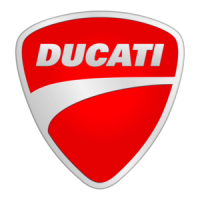

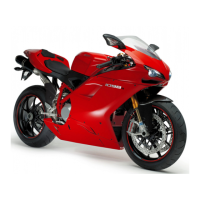
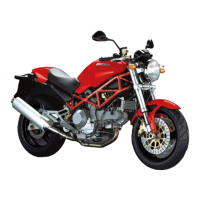
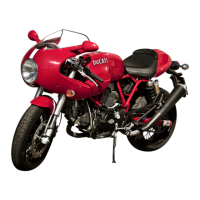
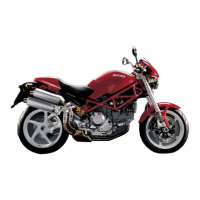
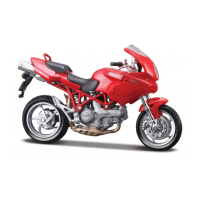
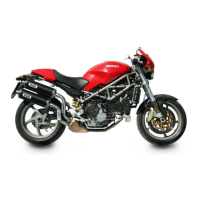
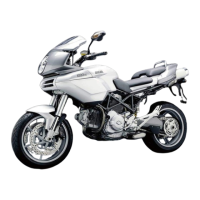


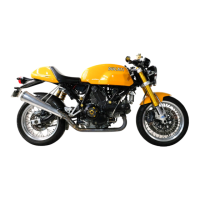
